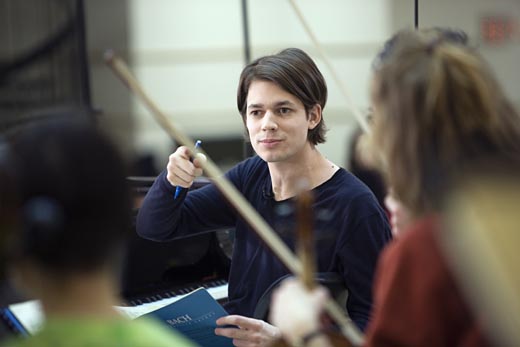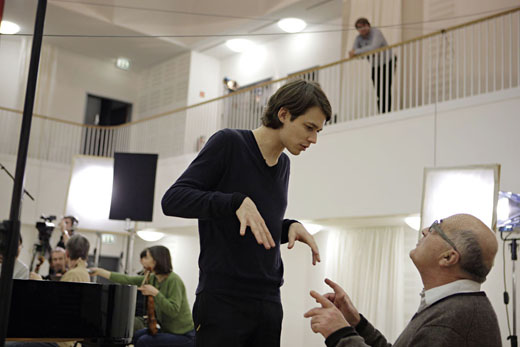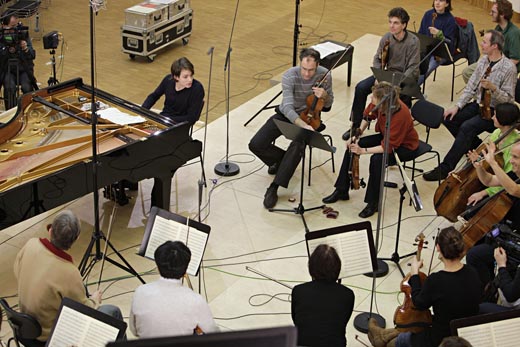David Fray
Sing, Swing & Think
In these hard times for the recording industry, many seasoned artists are not having their contracts renewed. As for younger artists, chances that they can arouse the interest of a record company are very slim indeed.
David Fray is such a blazing talent that he is one of the few pianists of the younger generation recently to have been signed exclusively by one of the current majors, Virgin Classics, following a uniquely successful concert given in Paris at the Théâtre du Châtelet in June 2006.
His first recording, recently released, was devoted to works by Johann Sebastian Bach and Pierre Boulez, a coupling which gives an intriguing idea of the originality of his repertoire.

rehearsing with the Deutsche Kammerphilarmonie, january 2008
photo J. Baier
In January 2008, David Fray recorded his second disc, in which he directed the Deutsche Kammerphilharmonie Bremen from the piano, with a programme this time comprising four piano concertos by Bach – concertos which, together with the famous Brandenburg Concertos, are among Bach’s most popular and stimulating works.
One of the main problems posed for the present-day performer of these works is that they have been “touched” by Glen Gould; this “rascal Gould, who has stamped his indelible mark on them”, as David Fray puts it. In other words, it’s a matter of finding a way of playing Bach after Gould. By copying him? That would be impossible and in any case pointless, if not ridiculous. By systematically distancing oneself from him? That would amount to making a futile, negative copy, of dubious interest.
But Bach’s music is so rich and boundless that there remain numerous exciting options for the performer’s imagination – assuming that he has any – and David Fray’s imagination happens to be one of his most striking characteristics.
In any case, the purpose of the film we have made about the recording of these Bach Concertos was to follow David Fray in his search for a completely personal way of approaching these sovereign works.

shooting in Bremen, january 2008 - photo J. Baier
We intended the film to have a seemingly simple structure. We set our mind on three situations – intercut, of course, in the editing – that would provide the background for the shooting sessions:
- David Fray at home. He is seen working on the score at the piano, explaining to us the various options which present themselves to him, while drawing numerous examples from the three Concertos we had selected for the purposes of the film. As I found out during the frequent working sessions I had with him prior to the shooting, the spontaneous enthusiasm and excitement music arouses in him often hit the mark in the most revealing way.
- Then, we find him rehearsing, or rather making music with, the Bremen orchestra. To my mind, the advantage of putting ourselves in a situation where the soloist is also acting as conductor, after having been present while he was working at home, and therefore having been able in advance to familiarize the listener with extracts from the works that he is exploring, would allow him, the listener, to get a really first-hand idea of the nature of this exploration.
- Finally, we proceeded to film three Concertos in their entirety. On account of its gaiety, its brevity and its extraordinary rhythmic vivacity, as well as the ineffable beauty of its slow movement, our choice fell upon the Concerto in A major; we followed this with the very popular Concerto in F minor, and the one in G minor, an arrangement made by Bach himself from his A minor Violin Concerto.

rehearsing with the Deutsche Kammerphilarmonie, january 2008
photo J. Baier
Bringing together a great pianist fully committed to the fantastic expressivity of Bach’s music, knowing precisely what he wanted and having the means to formulate it and carry it out, and a so-called “baroque” ensemble, was likely to create, as can be imagined, a situation of possible conflict. And in fact, such predictable moments of great tension between them did not fail to materialize. But just as tension and resolution are the basis of all music, the quality of their mutual understanding in the end resulted in a divine rapport such as should always exist when great musicians meet, setting aside any vanity and striving above all for the “higher interests” of art. (Incidentally, this dialectic of tension and release is not only of a musical nature; it is likewise eminently cinematic, and we have had recourse to it to shape the unseen skeleton underlying the final structure of this film.
True baroque style could never be confined within the limits of the quest for an illusory instrumental authenticity. It resides, beyond philology, in the spirit, and it is at that level that David Fray has captured it with such moving eloquence.
Bruno Monsaingeon.
about « Sing, Swing & Think : David Fray records J.S. Bach »
 Swing, sing and think. David Fray records J.S.Bach
Swing, sing and think. David Fray records J.S.Bach